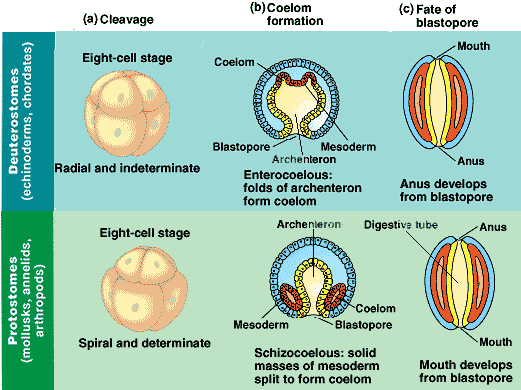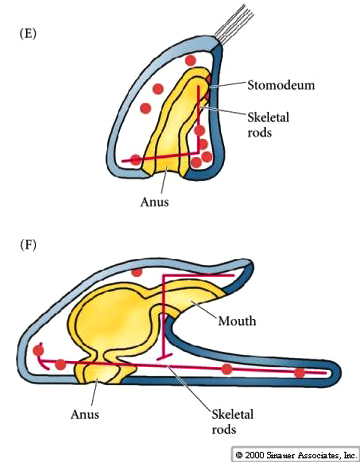
Subsequently, the centrally lying yolky cells of the mid-gut break down and become resorbed, and the remaining cells are rearranged around a new cavity which extends in a posterior direction from the liver diverticulum. For a time there is no cavity in the mid-gut, and the gut cavity ends with the liver diverticulum. At the same time, the cavity of the mid-gut (in urodeles and in most frogs) becomes occluded by the yolky endodermal cells. The part of the liver diverticulum posterior to the stomach retains a fairly broad cavity. The epithelium lining the pharynx becomes rather thin, in contrast to the lining of the rest of the alimentary canal. The lateral edges of the pharynx are drawn outward even more and form the pharyngeal pouches. The floor of the pharynx is raised, partially as a result of the increase of the heart rudiment, which develops just underneath. The part of the gut in front of the stomach rudiment also elongates, but instead of becoming tubular it is flattened dorsoventrally and expanded sideways. The tube is constricted to an extreme degree between the pharynx and the stomach and may even be temporarily occluded in this region, which becomes the rudiment of the esophagus, a very short section of the gut in the embryo. This ring contracts and at the same time broadens until eventually the rudiment of the stomach becomes more or less barrel-shaped, with a fairly narrow cavity. In the neurula stage, the presumptive material of the stomach is arranged in the form of a narrow ring, the ventral part of which lies just in front of the liver diverticulum, the dorsal part occupies the roof of the gut just at the mouth of the mid-gut, and the right and left parts obliquely cross the lateral walls of the foregut. This transformation can best be shown by considering the development of the stomach in the frog embryo. These rudiments become reshaped in the form of a narrow tube. The liver diverticulum becomes extended as a funnel-shaped invagination farther and farther in a posteroventral direction, drawing into it the rudiments which were originally located in the walls of the broadened cavity of the foregut (such as the rudiments of the anterior part of the duodenum, stomach, and esophagus). The significance of this perforation is not known.

It is rather remarkable that in frogs the liver diverticulum is extended downward and backward until the endoderm is perforated, and the gut cavity opens into the space between the endoderm and mesoderm on the ventral side of the embryo. The posterior pocket, bordering on the mass of yolk-laden cells of the mid-gut, is known as the liver diverticulum (or hepatic diverticulum) although in addition to giving rise to the rudiments of the liver and the pancreas it also participates in the formation of the stomach and the duodenum. The larger anterior one, lying immediately underneath the brain, gives rise to the cavities of the mouth and of the branchial region. The cavity is thus subdivided into two pocket-like recesses. In the neurula stage, the ventral wall of the foregut becomes flattened out and later even folded slightly upward. The wound healed easily, and the embryos continued to develop apparently quite normally. After the stain was taken up by the endodermal cells, the agar was removed. To stain the inner surface of the gut, cuts were made through the body wall (in some experiments through the neural plate), and pieces of agar soaked in vital stain were applied to the endoderm from the inside. The fate of the various parts of the endodermal lining of the fore- and mid-gut in amphibians has been elucidated by the method of local vital staining. The most posterior part of the cavity which adjoins the blastopore may be distinguished as the hindgut. The cavity of the mid-gut is narrower.ĭorsally it is lined by a rather thin epithelium, but the ventral wall consists of a mass of large cells containing abundant yolk, so that the wall here is very thick. The following portion is called the mid-gut.

This part is usually referred to as the foregut. The anterior portion is dilated and lined by a relatively thin endodermal epithelium.

The resulting endodermal cavity consists of three unequal portions.


 0 kommentar(er)
0 kommentar(er)
